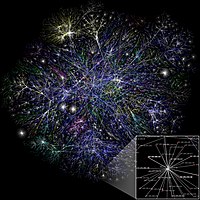
Photo from wikipedia
Pre-selected patterns on an n-type Si surface are fabricated by electrochemical etching in the presence of a weak optical signal. The constructive role of noise, namely, stochastic resonance (SR), is… Click to show full abstract
Pre-selected patterns on an n-type Si surface are fabricated by electrochemical etching in the presence of a weak optical signal. The constructive role of noise, namely, stochastic resonance (SR), is exploited for these purposes. SR is a nonlinear phenomenon wherein at an optimal amplitude of noise, the information transfer from weak input sub-threshold signals to the system output is maximal. In the present work, the amplitude of internal noise was systematically regulated by varying the molar concentration of hydrofluoric acid (HF) in the electrolyte. Pattern formation on the substrate for two different amplitudes (25 ± 2 and 11 ± 1 mW) of the optical template (sub-threshold signal) was considered. To quantify the fidelity/quality of pattern formation, the spatial cross-correlation coefficient (CCC) between the constructed pattern and the template of the applied signal was calculated. The maximum CCC is obtained for the pattern formed at an optimal HF concentration, indicating SR. Simulations, albeit using external noise, on a spatial array of coupled FitzHugh-Nagumo oscillators revealed similar results.Pre-selected patterns on an n-type Si surface are fabricated by electrochemical etching in the presence of a weak optical signal. The constructive role of noise, namely, stochastic resonance (SR), is exploited for these purposes. SR is a nonlinear phenomenon wherein at an optimal amplitude of noise, the information transfer from weak input sub-threshold signals to the system output is maximal. In the present work, the amplitude of internal noise was systematically regulated by varying the molar concentration of hydrofluoric acid (HF) in the electrolyte. Pattern formation on the substrate for two different amplitudes (25 ± 2 and 11 ± 1 mW) of the optical template (sub-threshold signal) was considered. To quantify the fidelity/quality of pattern formation, the spatial cross-correlation coefficient (CCC) between the constructed pattern and the template of the applied signal was calculated. The maximum CCC is obtained for the pattern formed at an optimal HF concentration, indicating SR. Simulations, albeit us...
Journal Title: Applied Physics Letters
Year Published: 2018
Link to full text (if available)
Share on Social Media: Sign Up to like & get
recommendations!